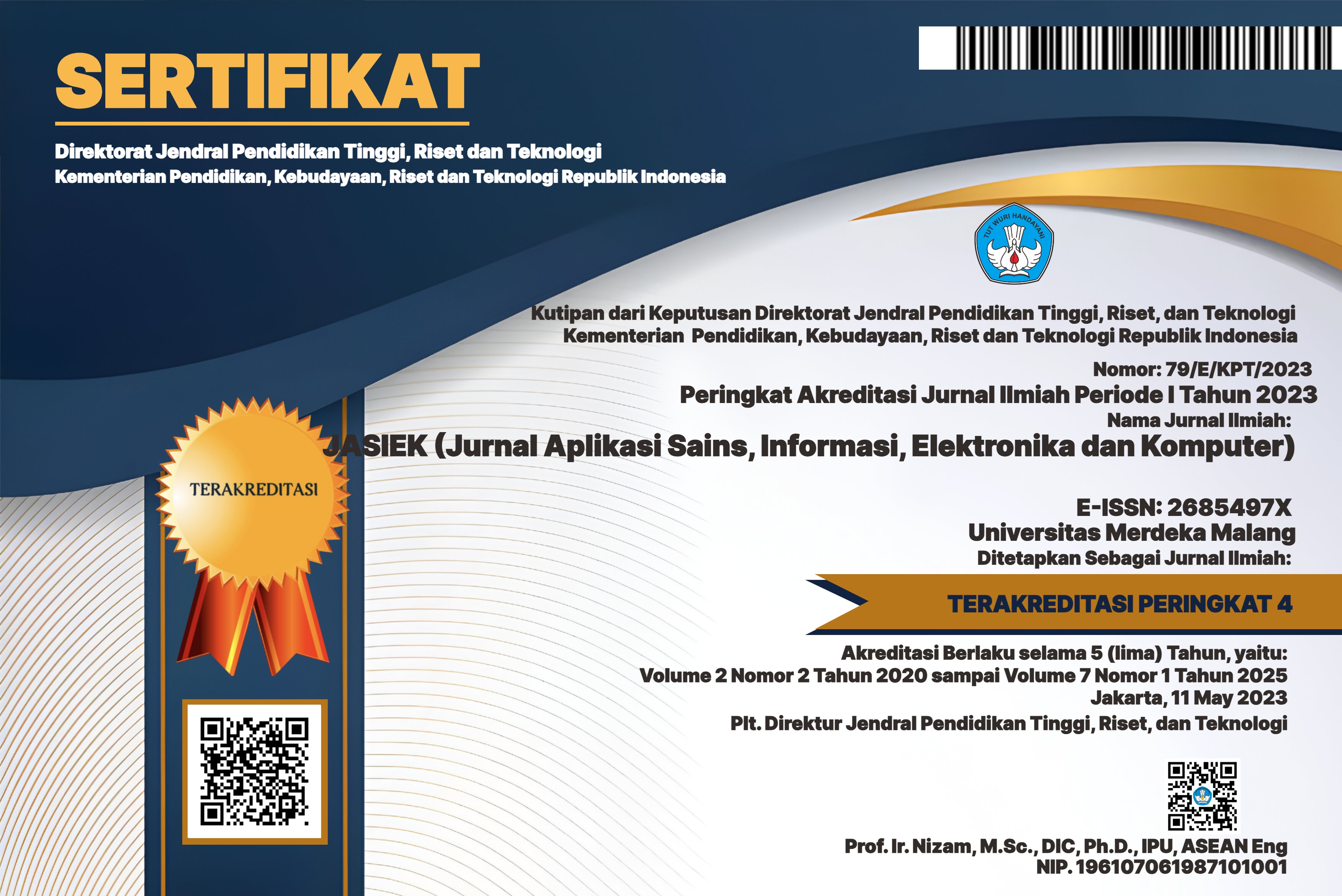Implementasi You Only Look Once (YOLO) dalam Deteksi Telur Menetas pada Reptil
DOI:
https://doi.org/10.26905/jasiek.v6i2.13525Keywords:
CNN, Epoch, Leopard Gecko, Reptil, YOLOAbstract
Saat ini reptil dijadikan hewan peliharaan karena perawatan yang mudah dan warna motif yang beragam salah satunya adalah Leopard Gecko. Perawatan Leopard Gecko yang baru menetas berbeda dari yang dewasa karena Leopard Gecko yang baru menetas harus segera ditempatkan di kandang yang diberi alas tisu dan disemprot air untuk menghindari kehilangan air. penelitian ini bertujuan untuk mengembangkan sistem deteksi telur menetas menggunakan YOLO (You Only Look Once). Hasil penelitian menunjukkan bahwa algoritma YOLO dapat digunakan untuk mendeteksi telur Leopard Gecko menetas secara real-time. persentase keberhasilan deteksi YOLO mencapai 94,73% pada jarak kamera 25 cm, pencahayaan 512-895 lux, dan 200 epoch pelatihan atau dapat mendeteksi 54 dari 57 objek. Jadi, model YOLO yang telah dilatih sudah memiliki keandalan yang baik dalam mendeteksi telur menetas pada reptil.
Downloads
References
[1] A. I. Asmarany and P. P. Setiawan, “PERBEDAAN KEBAHAGIAAN PADA INDIVIDU YANG MEMELIHARA MAMALIA ATAU REPTIL,” UG J., vol. 13, no. 12, pp. 46–57, 2022.
[2] I. S. Aditya Pratama, Beauty Anggraheny Ikawanty, “Sistem Kontrol dan Monitoring Suhu Serta Kelembapan Untuk Kandang Bayi Leopard Gecko Menggunakan Metode PI Berbasis IOT,” Sci. J. Ilm. dan Teknol., vol. 15, no. 1, pp. 72–86, 2024, doi: 10.25130/sc.24.1.6.
[3] Y. R. D. Wahana, “Sistem Pendukung Keputusan Pemilihan Morph Leopard Gecko Untuk Pemula Menggunakan Metode Simple Additive Weighting,” Politeknik Negeri Jember, 2021.
[4] P. Tani, “Cara Ternak Leopard Gecko,” anekabudidaya.com. Accessed: Jun. 21, 2024. [Online]. Available: https://anekabudidaya.com/cara-ternak-leopard-gecko/
[5] F. Rachmawati and D. Widhyaestoeti, “Deteksi Jumlah Kendaraan di Jalur SSA Kota Bogor Menggunakan Algoritma Deep Learning YOLO,” Pros. LPPM UIKA Bogor, pp. 360–370, 2020.
[6] A. N. Sugandi, B. Hartono, and K. Kunci, “Implementasi Pengolahan Citra pada Quadcopter untuk Deteksi Manusia Menggunakan Algoritma YOLO,” Pros. 13th Ind. Res. Work. Natl. Semin., pp. 13–14, 2022.
[7] I. Cholissodin and A. A. Soebroto, AI , MACHINE LEARNING & DEEP LEARNING ( Teori & Implementasi ), no. December. 2021.
[8] S. R. Dewi, “Deep Learning Object Detection Pada Video,” Deep Learn. Object Detect. Pada Video Menggunakan Tensorflow Dan Convolutional Neural Netw., pp. 1–60, 2018, [Online]. Available: https://dspace.uii.ac.id/bitstream/handle/123456789/7762/14611242_Syarifah Rosita Dewi_Statistika.pdf?sequence=1
[9] R. Windiawan and A. Suharso, “Identifikasi Penyakit pada Daun Kopi Menggunakan Metode Deep Learning VGG16,” Exploreit, vol. 13, no. 2, pp. 9–16, 2019, [Online]. Available: https://doi.org/10.35891/explorit
[10] R. Rikendry and A. Maharil, “Perbandingan Arsitektur Vgg16 Dan Resnet50 Untuk Rekognisi Tulisan Tangan Aksara Lampung,” J. Inform. dan Rekayasa Perangkat Lunak, vol. 3, no. 2, pp. 236–243, 2022, doi: 10.33365/jatika.v3i2.2030.
[11] E. Setyowati and S. Mariani, “Penerapan Jaringan Syaraf Tiruan dengan Metode Learning Vector Quantization ( LVQ ) untuk Klasifikasi Penyakit Infeksi Saluran Pernapasan Akut ( ISPA ),” Prism. Pros. Semin. Nas. Mat., vol. 4, pp. 514–523, 2021, [Online]. Available: https://journal.unnes.ac.id/sju/index.php/prisma/article/view/44356
[12] A. Salim, “Estimasi Kecepatan Kendaraan Melalui Video Pengawas Lalu Lintas Menggunakan Parallel Line Model,” 2020.
[13] L. O. A. S. Sagala, “Klasifikasi Cats dan Dogs dengan Metode CNN dalam Fungsi Aktivasi Relu , Sigmoid , Softmax , Softplus , Softsign , dan Selu,” Pros. Semin. Nas. Inform. Bela Negara di UPN “Veteran” Jawa Timur, vol. 2, no. 1, pp. 1–6, 2023.
[14] Bambang Pilu Hartato, “Penerapan Convolutional Neural Network pada Citra Rontgen Paru-Paru untuk Deteksi SARS-CoV-2,” J. RESTI (Rekayasa Sist. dan Teknol. Informasi), vol. 5, no. 4, pp. 747–759, 2021, doi: 10.29207/resti.v5i4.3153.
[15] H. Tantyoko, D. K. Sari, and A. R. Wijaya, “Prediksi Potensial Gempa Bumi Indonesia Menggunakan Metode Random Forest Dan Feature Selection,” IDEALIS Indones. J. Inf. Syst., vol. 6, no. 2, pp. 83–89, 2023, doi: 10.36080/idealis.v6i2.3036.
[16] Hadi Supriyanto, Sarosa Castrena Abadi, and Aliffa Shalsabilah, “Deteksi Helm Keselamatan Menggunakan Jetson Nano dan YOLOv7,” J. Appl. Comput. Sci. Technol., vol. 5, no. 1, pp. 1–8, 2024, doi: 10.52158/jacost.v5i1.637.
[17] N. D. G. Drantantiyas et al., “Performasi Deteksi Jumlah Manusia Menggunakan YOLOv8,” JASIEK (Jurnal Apl. Sains, Informasi, Elektron. dan Komputer), vol. 5, no. 2, pp. 63–68, 2023, doi: 10.26905/jasiek.v5i2.11605.
[18] N. Gunawan, T. Waras, and S. Si, KUASAI MACHINE LEARNING & COMPUTER VISION DALAM SEKEJAP. Padang, 2024.
[19] JOY HANS CHRISTABEL SINAGA, “EVALUASI KINERJA METODE KECERDASAN BUATAN BERBASIS YOLOv5 UNTUK DIAGNOSIS JENIS KANKER KULIT SECARA MOBILE REAL TIME,” 2024.
[20] M. Ikbal and R. A. Saputra, “PENGENALAN RAMBU LALU LINTAS MENGGUNAKAN METODE YOLOV8,” JIKA (Jurnal Inform. Univ. Muhammadiyah Tangerang, vol. 8, no. 2, pp. 204–212, 2024.
[21] L. Rahma, H. Syaputra, A. H. Mirza, and S. D. Purnamasari, “Objek Deteksi Makanan Khas Palembang Menggunakan Algoritma YOLO (You Only Look Once),” J. Nas. Ilmu Komput., vol. 2, no. 3, pp. 213–232, 2021, doi: 10.47747/jurnalnik.v2i3.534.
[22] N. Benarkah, M. F. Naufal, and B. Renatasiva, “YOLOv5 untuk Menghitung Sel Darah Merah dan Sel Darah Putih,” Keluwih J. Sains dan Teknol., vol. 5, no. 1, pp. 10–18, Apr. 2024, doi: 10.24123/saintek.v5i1.6291.
[23] Moh. Faizin, “IMPLEMENTASI ALGORITMA YOLO PADA MODUL KAMERA UNTUK DETEKSI JENIS DAN KECEPATAN KENDARAAN,” UNIVERSITAS JEMBER, 2023.
[24] Q. Antoko Mohti, R. Wahyudi, and M. Habib Mustofa, “Penerapan Metode YoloV5 Dalam Mendeteksi Penyakit Tanaman Buah Naga,” Semin. Nas. Teknol. Sains, vol. 3, no. 1, pp. 318–323, 2024.
[25] N. J. Hayati, D. Singasatia, and M. R. Muttaqin, “Object Tracking Menggunakan Algoritma You Only Look Once (YOLO)v8 untuk Menghitung Kendaraan,” Komputa J. Ilm. Komput. dan Inform., vol. 12, no. 2, pp. 91–99, 2023, doi: 10.34010/komputa.v12i2.10654.
Downloads
Published
Issue
Section
License
Copyright (c) 2024 JASIEK (Jurnal Aplikasi Sains, Informasi, Elektronika dan Komputer)

This work is licensed under a Creative Commons Attribution-NonCommercial-ShareAlike 4.0 International License.
Authors who publish with this journal agree to the following terms:
The journal allow the authors to hold the copyright without restrictions and allow the authors to retain publishing rights without restrictions.
Authors retain copyright and grant the journal right of first publication with the work simultaneously licensed under a Creative Commons Attribution-ShareAlike 4.0 International License that allows others to share the work with an acknowledgement of the work's authorship and initial publication in this journal.
Authors are able to enter into separate, additional contractual arrangements for the non-exclusive distribution of the journal's published version of the work (e.g., post it to an institutional repository or publish it in a book), with an acknowledgement of its initial publication in this journal.
Authors are permitted and encouraged to post their work online (e.g., in institutional repositories or on their website) prior to and during the submission process, as it can lead to productive exchanges, as well as earlier and greater citation of published work (See The Effect of Open Access).

This work is licensed under a Creative Commons Attribution-ShareAlike 4.0 International License.










